F-15E Strike Eagle
| F-15E Strike Eagle | |
|---|---|
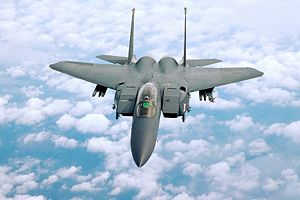 |
|
| Role | Strike fighter |
| Manufacturer | McDonnell Douglas/Boeing IDS |
| First flight | 11 December 1986 |
| Introduced | April 1988 |
| Status | Active |
| Primary users | United States Air Force Royal Saudi Air Force Israeli Air Force Republic of Korea Air Force |
| Unit cost | F-15E: US$31.1 million (1998)[1] F-15K: US$100 million (2006)[2] |
| Developed from | F-15 Eagle |
The F-15E Strike Eagle is a modern American all-weather strike fighter, designed for long-range interdiction of enemy ground targets deep behind enemy lines. A derivative of the F-15 Eagle air superiority fighter, the Strike Eagle proved its worth in Desert Storm, carrying out deep strikes against high-value targets, performing "Wild Weasel" (SEAD) patrols and providing close air support for coalition troops. The F-15E Strike Eagle can be distinguished from other U.S. Eagle variants by its darker camouflage and the conformal fuel tanks mounted along the engine intakes.
Contents |
Development
In March 1981, the USAF announced the Enhanced Tactical Fighter program to procure a replacement for the F-111 Aardvark. The concept envisioned an aircraft capable of launching deep interdiction missions without requiring additional support by fighter escort or jamming. General Dynamics submitted the F-16XL, while McDonnell Douglas submitted a variant of the F-15 Eagle. On 24 February 1984, the USAF awarded the ETF to McDonnell Douglas's F-15E Strike Eagle.[3]

The F-15E's first flight was on 11 December 1986.[3] The first production model of the F-15E was delivered to the 405th Tactical Training Wing, Luke Air Force Base, Ariz., in April 1988. The "Strike Eagle", as it was dubbed, received initial operational capability on 30 September 1989 at Seymour Johnson AFB in North Carolina with the 4th Tactical Fighter Wing, 336th Tactical Fighter Squadron.[3]
Variants of the F-15E have been developed for Israel (F-15I), Korea (F-15K), Saudi Arabia (F-15S), and Singapore (F-15SG).
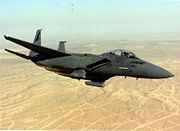
The F-15E will be upgraded with the Raytheon APG-63(V)4 Active Electronically Scanned Array (AESA) radar after 2007. It combines the processor of the APG-79 used on the F/A-18E/F Super Hornet with the antenna of the APG-63(V)3 AESA being fitted on the F-15C.[4] The radar upgrade is expected to begin in 2008.[5]
While most of the F-15C/Ds are being replaced by the F-22 Raptor there is no slated replacement for the F-15E. The Strike Eagle is a more recent variant of the F-15, and has a sturdier airframe rated for twice the lifetime of earlier variants. The F-15Es are expected to remain in service past 2025.[6] The Air Force is currently pursuing the 2018 Bomber, a medium bomber concept which could also take over the Strike Eagle's "deep strike" profile. The "A" variant of the F-35 Lightning II, which is projected to eventually replace many other attack aircraft such as the F-16 and A-10, could also take over much of the F-15E's role.
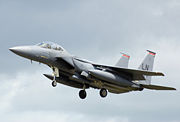
Design
The F-15E's deep strike mission is a radical departure from the original intent of the F-15, since the F-15 was designed as an air superiority fighter under the mantra "not a pound for air-to-ground."[7] The basic airframe, however, proved versatile enough to produce a very capable strike fighter. While designed for ground attack, the F-15E retains the air-to-air lethality of the F-15, and can defend itself against enemy aircraft.[8]
The F-15E prototype was a modification of the two-seat F-15B. Despite its origins, the F-15E includes significant structural changes and much more powerful engines. The back seat is equipped for a Weapon Systems Officer (WSO pronounced Wizzo), or known to some as the "guy in back" (GIB), to work the new air-to-ground avionics. The WSO uses multiple screens to display information from the radar, electronic warfare or infrared sensors, monitor aircraft or weapons status and possible threats, select targets, and use an electronic "moving map" to navigate. Two hand controls are used to select new displays and to refine targeting information. Displays can be moved from one screen to another, chosen from a "menu" of display options. Unlike earlier two-place jets (like the F-4 Phantom II and Navy's F-14 Tomcat), whose "backseater" lacked flying controls, the back seat of the F-15E cockpit is equipped with its own stick and throttle so the WSO can take over flying if necessary, albeit with reduced visibility.[9]

To extend its range, the F-15E is fitted with two conformal fuel tanks (CFTs) that hug the fuselage, producing lower drag than conventional underwing/underbelly fuel tanks. They carry 750 U.S. gallons (2,800 liters) of fuel, and house six weapons hardpoints in two rows of three in tandem. However, unlike conventional fuel tanks, CFTs cannot be jettisoned, so increased range comes at the cost of degraded performance as a result of the additional drag and weight versus a totally "clean" configuration. Similar tanks can be mounted on the F-15C/D and export variants, and the Israeli Air Force does exercise this option on their fighter-variant F-15s as well as their F-15I variant of the Strike Eagle, but the F-15E is the only U.S. variant to be routinely fitted with CFTs.
The Strike Eagle's tactical electronic warfare system (TEWS) integrates all countermeasures on the craft: radar warning receivers (RWR), radar jammer, radar, and chaff/flare dispensers are all tied to the TEWS to provide comprehensive defense against detection and tracking. This system includes an externally mounted ALQ-131 ECM pod which is carried on the centerline pylon on an as needed basis.
An inertial navigation system uses a laser gyroscope to continuously monitor the aircraft's position and provide information to the central computer and other systems, including a digital moving map in both cockpits.

The APG-70 radar system allows air crews to detect ground targets from longer ranges. One feature of this system is that after a sweep of a target area, the crew freezes the air-to-ground map then goes back into air-to-air mode to clear for air threats. During the air-to-surface weapon delivery, the pilot is capable of detecting, targeting and engaging air-to-air targets while the WSO designates the ground target.
The low-altitude navigation and targeting infrared for night (LANTIRN) system, mounted externally under the engine intakes, allows the aircraft to fly at low altitudes, at night and in any weather conditions, to attack ground targets with a variety of precision-guided and unguided weapons. The LANTIRN system gives the F-15E exceptional accuracy in weapons delivery day or night and in poor weather, and consists of two pods attached to the exterior of the aircraft. At night, the video picture from the LANTIRN can be projected on the HUD, producing an image similar to what the pilot would see during daytime.
The navigation pod contains terrain-following radar which allows the pilot to safely fly at a very low altitude following cues displayed on a heads up display. This system also can be coupled to the aircraft's autopilot to provide "hands off" terrain-following capability. Additionally, the pod contains a forward looking infrared system which is projected on the pilot's HUD which is used during nighttime or low visibility operations. The AN/AAQ-13 Nav Pod is installed beneath the right engine intake.
The targeting pod contains a laser designator and a tracking system that mark an enemy for destruction as far away as 10 mi (16 km). Once tracking has been started, targeting information is automatically handed off to infrared air-to-surface missiles or laser-guided bombs. The targeting pod is mounted beneath the left engine intake; configurations may be either the AN/AAQ-14 Target Pod, AN/AAQ-28 LITENING Target Pod or the AN/AAQ-33 Sniper Pod.
For air-to-ground missions, the F-15E can carry most weapons in the U.S. Air Force inventory. It also can be armed with AIM-9 Sidewinders, AIM-7 Sparrow and AIM-120 AMRAAMs for self-defense (though the Strike Eagle retains the counter-air capabilities from its Eagle lineage, it is rarely if ever used for counter-air missions). Like the F-15C, the Strike Eagle also carries an internally mounted General Electric M61A1 20 mm cannon which is effective against enemy aircraft and "soft" ground targets.
Operational history
United States
Operations Desert Shield and Desert Storm

The F-15E was thrown into action when Iraq invaded Kuwait in August 1990. The 335th Tactical Fighter Squadron "Chiefs" and 336th Tactical Fighter Squadron "Rocketeers" were given orders to prepare for deployment one week after the invasion. The 336th began their flight to Seeb Air Base in Oman, a 15 hour flight. Though mission-ready, the F-15Es were not cleared to carry the needed munitions to counter a possible Iraqi attack on Saudi Arabia; they were cleared to carry only the 500 lb (230 kg) Mark 82 bomb and 2,000 lb (910 kg) Mark 84 bomb. Cluster bombs are the preferred weapon when attacking vehicles, and these had not been fully tested from all weapon stations on the Strike Eagle. During training operations in Oman, one F-15E (336th) was lost on 30 September in a mock dogfight against Royal Air Force Jaguar GR.1s that resulted in the deaths of the pilot and WSO. In December, the two F-15E squadrons were moved closer to Iraq, and deployed to Al Kharj Air Base in Saudi Arabia.
On 17 January 1991, 24 F-15Es attacked five fixed SCUD sites in western Iraq and missions against SCUD sites continued through the night with a second strike package consisting of 21 F-15Es. During the war, F-15Es flew hunter missions during the night over western Iraq, searching after mobile SCUD launchers that threatened neighboring countries. These mobile SCUD launchers were very elusive; if JSTARS found a launch point, the mobile SCUD launchers most of the time would be gone when the F-15Es arrived. By conducting random bombings in suspected areas, F-15E crews hoped to deter the Iraqis from setting up for a SCUD launch.
On the first day of the war, approaching H-2 airfield, a formation of Strike Eagles were tracked by three Iraqi MiG-23s and two MiG-29s and there were two notable opportunities for the F-15E to claim its first air-to-air kill. On the opening night one F-15E tracked a MiG-29 and attempted to engage it but had difficulties in acquiring the MiG-29's thermal signature in order to target an AIM-9 Sidewinder. The missile was eventually fired but failed to hit its target. Several other F-15Es simultaneously tried to engage the lone MiG-29 but errors and bad luck prevented them from getting the kill. One F-15E was actually flying past the Iraqi jet and maneuvered in for the kill but the pilot hesitated to take the shot both because he was unsure where his wingmen were and because he didn’t get a good tone with the Sidewinder missile. Soon after, a missile of unknown origin was launched in the area and shortly after that the MiG hit the ground as the Iraqi pilot tried to engage an F-15E. Another MiG-29 was shot down by his own wingman and an F-15E was close by to yet another MiG-29, but the pilot elected not to engage as there were USN F-14s on the way to the area.[10][11]
On the night of 18 January, during a strike against a Petrol Oil and Lubricant plant near Basrah, an F-15E was lost to enemy fire and the pilot and WSO were killed. F-15E crews described this mission as the most difficult and dangerous mission of the war as it was heavily defended by SA-3s, SA-6s, SA-8s and Rolands as well as of anti-aircraft artillery. Two nights later, a second and final F-15E was downed by an Iraqi SA-2; the crew survived and managed to evade capture for several days and were even in contact with two coalition aircraft, but SAR crews were unable to rescue them due to security issues as one of the downed airmen did not properly identify himself on the radio with proper codes. The two airmen were later captured by the Iraqis.
Even though air-to-air kills had eluded the F-15Es, four Strike Eagles destroyed 18 Iraqi jets at Tallil air base using GBU-12s and CBU-87s, but on 14 February, their luck changed as an F-15E scored its first and only air-to-air kill: a Mil Mi-24 Hind helicopter. The attack was in response to a request for help by US Special Forces, when five Iraqi helicopters were spotted. The lead F-15E of a formation of two (from the 335th) acquired a helicopter unloading Iraqi soldiers through the FLIR pod and released a GBU-10. After 30 seconds, the F-15E crew thought the bomb had missed its target and the pilot was about to use a Sidewinder missile instead, but suddenly the Hind helicopter was vaporized. The Special Forces team estimated that the Hind was roughly 800 feet (240 m) over the ground when the 2,000 lb (910 kg) bomb hit its target.[12] But the air-to-air kill was not recognized until 2 November 2001. They tried to engage the other helicopters but an allied bombing started around the F-15E so the pilot decided to get out.[10]
F-15E Strike Eagles continued to hunt SCUD missiles during the war and attack heavily defended targets all throughout Iraq. They also conducted secret missions attempting to kill Saddam Hussein, bombing what were believed to be places where the Iraqi president was hiding, but with no luck. As the ground war was coming closer, F-15Es began tank plinking, attacking Iraqi tanks and armoured personnel carriers in Kuwait.
Following 42 days of heavy combat for the F-15Es, a cease fire came into effect on 1 March 1991. Northern and Southern no-fly zones were quickly established over Iraq to prevent Iraqi aircraft from posing a threat to the Coalition. Despite this, Iraqi helicopters struck Kurdish refugees in northern Iraq. The F-15Es enforcing the no-fly zone watched helplessly as 600 civilians in the village of Chamchamal were attacked by helicopters. Since the F-15Es were not allowed to open fire, the aircraft made high speed passes as close as they dared in the hope that their wake turbulence would snap a rotor blade. They also fired their lasers into the cockpits of the Iraqi helicopters with intention of blinding the pilots. The latter technique was ineffective but the former did cause one Hind to crash. Soon USAF leadership became aware of these activities and ordered F-15Es not to fly below 10,000 feet (3,000 m). F-15Es flew in support of Operation Provide Comfort and Operation Provide Comfort II.[13]
Operations Southern Watch and Northern Watch
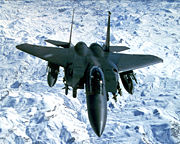
Following Desert Storm two no-fly zones were set up over Iraq and were policed mainly by US and UK aircraft. F-15Es from 494th Fighter Squadron "Black Panthers" deployed to Turkey in 1993, 1994 and 1997. The 492d Fighter Squadron "Madhatters" deployed in 1995, 1996 and 1997. The 391st FS deployed later the same year. F-15Es would fly into combat over the next decade on numerous occasions. In January 1993, a small package hit Iraqi targets that broke the rule of the ceasefire agreement below the 32nd Parallel, an SA-3 was targeted. A few days later, ten F-15Es took part in another punitive strike.[14] Most of the time missions flown in support of OSW and ONW were defensive; as the Strike Eagles could carry a lot of weapons of various types into a mission, it gave the F-15 crews a lot of flexibility. The F-15Es operated under the close supervision of AWACS and crews could receive airborne taskings and could fly unplanned attacks against Iraqi targets.
During the next three years, violations of the no-fly zones were minimal as Iraq slightly withdrew its forces, and in 1997 Turkey approved the creation of ONW and permitted US forces to use the Incirlik air base. In December 1998, Operation Desert Fox was conducted because Iraq refused UNSCOM inspections.
On 28 December, three F-15Es each dropped two GBU-12 500-pound precision-guided munitions (PGMs). Two of the F-15Es hit an SA-3 target site tracking radar and optical guidance unit. The other F-15E had one bomb hit the SA-3 missile site command and control van, and the other hit the target site tracking radar and optical guidance unit. The other F-15E in the four-ship formation did not drop any bombs because it did not have positive target identification.
After Desert Fox, Iraq stepped up its violations of the no-fly zones and a lot of retaliatory and pre-planned strikes were conducted by F-15Es. In ONW alone, weapons were expended on no fewer than 105 separate days. Between 24 January and 26 January 1999, F-15Es expended several AGM-130s and GBU-12s against SAM sites in northern Iraq near Mosul.[15]
F-15Es were the most highly-tasked of all USAF tactical fighters, mostly due to their low number compared to the F-16s in the region. F-15Es usually attacked ammunition bunkers, command and control facilities, towed 100 mm KS-19 anti-aircraft batteries and SA-3/6 launchers. F-15Es would also fly combat air patrols over Iraq and also co-operated with other aircraft in strikes, such as USN F-14s, F/A-18s and EA-6Bs as well as USAF F-16s.
Operations Deny Flight and Operation Allied Force
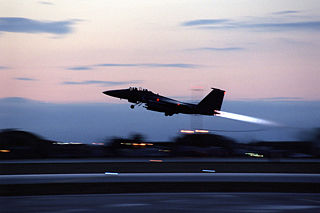
Operation Deny Flight was a United Nations enforced no-fly zone over Bosnia and Herzegovina as the situation in the Balkans had deteriorated over many years. In August 1993, after a UN Security Council resolution that banned all fixed and rotary wing aircraft unless authorized by the UN, F-15E’s from 492d and 494th FS deployed to Aviano in Italy. By late 1993, the situation had worsened and NATO ordered a limited F-15E strike against Serbian targets in Croatia, targeting the Ubdina airfield. Eight F-15Es armed with GBU-12s were to attack an SA-6 as part of a 30-aircraft strike package. The mission was cancelled in mid-flight as the F-15Es could not prosecute the attack due to stringent Rules of Engagement.[16] In December the same year F-15Es were launched to destroy a pair of SA-2 sites which had opened fire on two Royal Navy Sea Harrier FRS 1s.[17] Most missions flown by the Strike Eagles were non-combat sorties, but they were fired upon quite often. In August 1995, 90th Fighter Squadron joined the two other F-15E squadrons. The 492d and 494th had flown over 2500 sorties since Deny Flight had begun, and 2000 of these were credited to 492d as they had been deployed longer than 494th. On 30 August and 31 August, strikes were carried out with GBU-10s and GBU-12s, F-15Es struck Serbian armor and supplies around Sarajevo. On 5 September more GBU-12s were dropped and four days later a GBU-15 were dropped for the first time from a Strike Eagle, and in the end nine were dropped against air defense targets and Bosnian-Serb ground forces around Banja Luka.[17]
In 1999, Operation Allied Force was launched following the displacement of Kosovars. After the government of Serbia rejected a NATO ultimatum, OAF was launched in March 1999. 26 F-15Es from the 492d and 494th FS in-theatre concentrated the first strikes of the war against Serb surface-to-air-missile sites, anti-aircraft batteries and Early Warning radar stations.[18] These Strike Eagles were deployed to Aviano as well as Lakenheath in Great Britain, the only Strike Eagle units in the USAF to conduct Close Air Support missions, which was a new idea in the late 1990s but is now conducted by the entire air force (F-15Es, F-16s and A-10s).[19] Most missions would last around 7.5 hours and included two aerial refuellings and F-15Es would carry a mix of air-to-air and air-to-ground missions so they could fly both a Combat Air Patrols and then drop bombs on targets before returning home.[19]
The largest threats to allied aircraft were the Serb's mobile SAM launchers. F-15E crews were very vigilant towards this threat as several aircraft had been lost in the past, most notably the F-117 that was shot down during the war. When the threat was too great, or specific weapon effects were required, the AGM-130 was used to provide stand-off distance to the target.[20] It was used against two MiG-29s on the ground with great success. The AGM-130 is a very expensive weapon and was only used against specific targets or when crews wanted to control their weapon in the flight to achieve maximum efficiency against targets. The WSO can steer the weapon to the target, or even abort and steer the weapon in to the ground far away from civilians if a target is too close to civilian areas such as churches. It was off-limits for NATO crews to attack targets around such buildings. It was an F-15E armed with an AGM-130 that struck a bridge just as a passenger train crossed, resulting in the loss of 14 civilian lives. In June 1999 Slobodan Milosevic ordered withdrawal from Kosovo.
Operation Enduring Freedom

Following the September 11, 2001 attacks, 391st Fighter Squadron "The Bold Tigers" left for Ahmed Al Jaber air base in Kuwait 31 days later. The unit had been scheduled to participate in Operation Southern Watch, but now they were going to support Operation Enduring Freedom. During the first attacks the F-15Es and met little resistance, and for the first night's military buildings, Taliban supply depots, caves and al-Qaeda training camps were the main targets. Both the AGM-130 and GBU-15 2,000 lb (910 kg) bombs were expended, and this was the first combat experience with the GBU-15.[21] GBU-24s and GBU-28s were used against reinforced targets, command and control centres and cave entrances. F-15Es would often operate as two-ship flights alongside two-ship F-16Cs. Within weeks almost all targets had been destroyed and it was hard to find meaningful targets. The Taliban had access to SA-7 and FIM-92 Stinger portable surface-to-air missiles which posed no threat towards US aircraft as long as they flew above 7,000 feet (2,100 m), and the fixed SAM sites near such cities as Mazar-I-Sharif and Bagram were struck very early in the campaign, so it was a very "low-threat" environment.[22]
Within three weeks, aircraft began to fly on-call support missions for allied ground forces where F-15Es usually carried MK-82 and GBU-12 bombs, but also other weapons were carried, and during one mission a GBU-28, two GBU-24s and six GBU-12s were released.[22] The most frequent targets during the rest of the war were people, vehicles and convoys, and not only bombs were expended, on several occasions F-15Es used the internal gun as well.[23] During the course of the three-month deployment in support of OEF, four 391st crews conducted the longest fighter mission in history; it lasted 15.5 hours and nine of those were spent over the target area. Two F-15Es attacked two Taliban command and control facilities, two buildings suspected to shelter Taliban fighters, and a Taliban road block. The F-15Es refueled 12 times during the mission.[24] On 7 January 2002 the 391st FS returned home and 335th FS took over, the 391st FS had flown two to eight sorties a day during their deployment. The 391st would highlight their deployment by expending the BLU-118/B for the first time in combat; it was used to flush out Taliban fighters hiding in caves.
The other highlight of the deployment occurred on 4 March when a section of F-15Es supported what would be known as the Battle of Roberts’ Ridge. The F-15Es first flew an on-call Close Air Support mission for "Texas 14" on the ground by destroying a Taliban observation position. 16 minutes later, at 0141 hours, "Mako 30" had come under mortar fire and the F-15Es rushed to the location. It was soon learned that the soldier in contact with the F-15Es was not a Forward Air Controller. It was later learned that the solder was a Navy SEAL, and part of a team searching for an MH-47E Chinook following an ambushed insertion point in the Shah-i-Kot Valley.[25] Nonetheless, the F-15Es dropped a GBU-12, but the SEAL team was still taking fire as they moved east with two wounded and one Killed In Action. A second bomb was dropped, but due to the wrong coordinates being entered into the Strike Eagle's computer the weapon missed.[25] During the effort to support the SEAL Team a MH-47 carrying a rescue team was downed by an RPG.[26]
During all this, the F-15Es had just finished refueling and were instructed to work with "Texas 14", a third team on the ridge. The F-15Es dropped eleven GBU-12s between 0252 and 0303 hours to aid the forces on the ground. Soon the F-15Es had to support the survivors from the downed MH-47 that had enemy contact some 75 meters from their position. The Strike Eagles could not use bombs, so they went with guns; they used the downed helicopters as a reference point and started to make gun passes.[26] One Strike Eagle had to get back to the tanker, and the lone F-15E talked to AWACS to get some other aircraft to this location to strafe as well. A section of F-16s from 18th Fighter Squadron arrived and made some passes as well. It was soon decided that they had to drop bombs, as both the Strike Eagles and the Falcons had run out of ammunition. The F-15Es by now had been instructed by AWACS to return home, but they could support the forces and then return immediately after that. After some problems with radios and weapons that failed to drop, the F-15Es eventually each dropped a GBU-12 and requested to drop the remaining bombs, but were ordered to return to Al Jaber in Kuwait.[27]
On 23 August 2007, an F-15E, called in for close air support north west of Kajaki, Afghanistan, mistakenly dropped a 500 lb (230 kg) bomb on British forces, killing three privates.[28]
Operation Iraqi Freedom
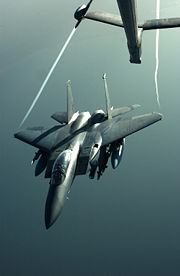
In late 2002, tension over suspected Iraqi weapons of mass destruction was growing, and the 4th Fighter Wing at Seymour Johnson AF Base, in North Carolina (the largest F-15E Strike Eagle operator in the world) was soon ordered to have at least one squadron ready to deploy to the Persian Gulf. The 336th was selected to deploy first, to the Al Udeid air base in Qatar. Between 11 January and 17 January 2003, 24 aircraft deployed to the air base and preparations began which involved a briefing by planners from the Combined Air Operations Center at Prince Sultan Air Base in Saudi Arabia. The 336th was grounded for some time until 27 January when the governments of the United States and Qatar concluded their diplomatic problems and permissions to fly was finally given.[29] The F-15Es began flying missions in support of Operation Southern Watch, mostly surveillance and reconnaissance missions as well as "Strike Familiarization" missions, which basically meant the air crews flew simulated missions against potential targets in Iraq, and if needed they could attack them as well, as well as familiarize themselves with Rules of Engagements, local area procedures, working with AWACS and flying over hostile territory.[29] During OSW F-15Es attacked targets mostly in southern and western Iraq, radars, radio relay stations, communications sites, leadership targets and air defence positions were targeted. On one night four F-15Es dropped GBU-24s into the Iraqi Republican Guard/Baath Party HQ in Basrah while another four-ship flight flattened a nearby Air Defense Sector HQ with six GBU-10s.[30]

Towards the end of February the 336th received additional aircrews and the units consisted of 150 pilots and WSOs, many of them were drafted from the two non-deployable fighter squadrons at Seymour Johnson (the 333d Fighter Squadron and 334th Fighter Squadron) and 391st Fighter Squadron at Mountain Home Air Force Base, this meant that there were four aircrews per F-15E.[30] In early March, the 335th Fighter Squadron's personnel and aircraft were deployed and joined the 336th at Al Udeid. One objective at the end of OSW was to take down Iraq's air defenses and Early Warning radar network near the border to Jordan so F-16s and Special Forces helicopters could operate from out of Jordan when the war started. Several radar sites and radio relay stations were hit in western Iraq near the "H3" airfield, during these missions’ coalitions jets were greeted by heavy anti-aircraft artillery.[31]
The exact date of when the war started for the F-15E crews is unknown because of the Rules of Engagements criteria. By the time F-117s dropped bombs over Baghdad on 19 March, on a house where Saddam Hussein was believed to be, F-15Es dropped GBU-28s around the H3 airfield and other F-15Es conducted strikes part of OSW, and as Tomahawk missiles made their way up north to Baghdad, F-15Es were on their way into Iraq in support of OSW. On 20 March, the war was had more or less begun from a ROE standpoint and F-15Es dropped AGM-130s against key communication, command and control buildings, and leadership targets in Baghdad, but a few of the weapons missed their intended targets, the weapons are believed to have been effected by EA-6B Prowlers conducting jamming operations in the vicinity.[32] F-15Es would work closely with Special Forces operating deep inside Iraq, these missions being highly classified and only veteran F-15E crews participated in these missions. F-15Es would usually circle around an area and the Special Forces directed the Strike Eagles onto targets within the area. On more than one occasion the F-15E crews would use their guns to strafe targets such as cars that posed a threat towards the Special Forces teams because the targets were too close to the Special Forces team for a bomb to be used.

On 3 April 2003 a F-15E pilot mistook a Multiple Launch Rocket System (MLRS) for an Iraqi surface-to-air missile site and dropped a 500 lb (230 kg) laser guided bomb on it, killing Sgt. Donald Oaks, Sgt. Todd J. Robbins, and Sgt. First Class Randall S. Rehn and wounding five others.[33]
On 7 April 2003 an F-15E (88-1694), crewed by Captain Eric "Boot" Das and Major William "Salty" Watkins were dropping bombs on targets around Tikrit when they crashed.[34] The crew was posthumously awarded the Distinguished Flying Cross for "a critical interdiction tasking in support of Special Operations Forces" on the day prior to the crash and the Purple Heart.[35]
During the war, F-15Es were credited with destroying 60% of the total force of the Iraqi Medina Republican Guard. They also scored hits on 65 MiGs on the ground,[31] and destroyed key air defense and command buildings, which saw F-15Es flying deep into the well protected areas of Baghdad. During the war F-15Es worked closely with other jets that were deployed to Al Udeid, including RAAF F/A-18s, USAF F-16s and F-117s, RAF Panavia Tornado fighters and a detachment of US Navy F-14s from VF-154. All kind of aircraft used the F-15E to find, identify and hand-off targets to them, including B-1Bs, B-52s, Navy/Marine Corps F/A-18, AV-8Bs and F-14s.
In mid-2003, the 335th and 336th redeployed home. The 494th Fighter Squadron was deployed to Al Udeid to continue the Strike Eagle presence.
Non-US operators
The F-15I is operated by the Israeli Defence Force/Air Force No 69 Hammers Squadron, which had previously been operating the F-4 Phantom. The first F-15I combat mission was flown in Lebanon on 11 January 1999. The aircraft can carry: the AIM-9L, Rafael Python 4 and the Rafael Python 5 infrared-homing missiles; and the AIM-7 Sparrow and the AIM-120 AMRAAM radar-guided missiles. The Python 4 can be launched at up to 90 degrees off boresight, with the pilot aiming using the helmet-mounted sight. For BVR engagements, it can use either the AIM-7 or the AIM-120.
In 1999, Israel announced its intention to procure more fighter aircraft, and the F-15I was a possible contender. However, it was announced that the contract would go to the F-16I, a specialized version of the Fighting Falcon.
On 7 June 2006, an F-15K crashed off the coast of Pohang, North Gyeongsang Province, South Korea, during a nighttime intercept training mission, killing both crew members. The ROKAF commissioned a full investigation. The Republic of Korea Air Force later issued a public statement saying that the accident was apparently caused by both crew members entering a state of g-LOC that lasted 16 seconds and resulted in loss of control of the aircraft. Subsequent public outcry ensued with accusations of a cover-up because the blackbox was never recovered, and F-15Ks are equipped with automatic GLC (G Limited Control anti g-LOC device) systems. In addition the crew members were both seasoned Air Force veterans and the claim that both of them lost consciousness simultaneously was questioned in the press.[36]
Variants
F-15I
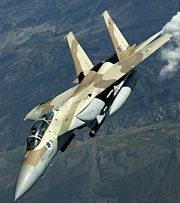
The F-15I is deployed by the Israeli Air Force where it is known as the Ra'am (רעם - "Thunder"). It is a dual-seat ground attack aircraft powered by two Pratt & Whitney F100-PW-229 engines, and is based on the F-15E.
After the Gulf War, in which Israeli towns were attacked by SCUD missiles based in Iraq, the Israeli government decided that it needed a long range strike aircraft. In 1993, Israel issued a Request for Information (RFI) asking any aircraft companies interested in producing the new Israeli fighter for their proposals.
In response, Lockheed Martin offered a version of the F-16 Fighting Falcon and McDonnell Douglas offered both the F/A-18 Hornet and the F-15E. On 27 January 1994, the Israeli government announced that they intended to purchase 21 F-15Es. The F-15E design was modified to Israeli requirements, including the DASH Helmet Mounted Sight and was renamed F-15I. On 12 May 1994, the US Government authorized the purchase of up to 25 F-15Is by Israel. In November 1995, Israel purchased 4 more F-15Is, bringing them to the US imposed limit.
Changes for F-15I
The F-15I Ra'am (Hebrew: Thunder) is very similar to the F-15E but the F-15I has some avionics systems specifically adapted to meet Israeli requirements. To facilitate night-time strikes, the F-15Is were initially fitted with the Sharpshooter targeting pods which were designed for Israeli F-16s. The Sharpshooter pod is less capable than the LANTIRN pods used on the F-15E, so when the United States allowed Israel to buy LANTIRNs they took the offer. This purchase completed the F-15I's night vision suite, with 30 LANTIRNs eventually delivered. After these modifications the F-15I was almost identical to the F-15E. The only significant difference remaining between the F-15I and the F-15E is that the F-15Is were delivered without Radar Warning Receivers. Israel installed its own electronic warfare equipment in its F-15s. The F-15Is' missing electronics have been replaced by the Israeli Elisra SPS-2110 Integrated Electronic Warfare System. A central computer and embedded GPS/INS system have also been fitted. All of the aircraft's sensors can be slaved to the Display And Sight Helmet (DASH) helmet-mounted sight, giving both crew members an efficient targeting mechanism that the F-15E does not possess. The Ra'am's advanced systems include an APG-70 radar with terrain mapping capability. The sharp picture that the APG-70 provides, regardless of weather conditions and light, makes it possible to locate targets that are otherwise very hard to find — e.g., missile batteries, tanks and structures — even under such adverse conditions as complete fog cover, heavy rain or moonless nights.
F-15K

The F-15K Slam Eagle (Korean: F-15K 슬램이글) is an advanced derivative of the F-15E, ordered and being delivered to Republic of Korea Air Force (ROKAF).
In 2002, ROKAF selected the F-15K for its F-X fighter program after the fierce competition of four fighters: the F-15K from Boeing, the Rafale from Dassault-Breguet, the Eurofighter Typhoon, and Su-35 from Sukhoi. A total 40 aircraft were ordered with deliveries beginning in 2005.[37]
F-15K has many advanced features not found on F-15E, such as an AAS-42 IRST (Infrared Search and Track), JHMCS (Joint Helmet-Mounted Cueing System), and advanced AN/APG-63(V)1 MSA radar. AESA Radar (Active Electronically Scanned Array) is also available as an option. In addition, the F-15K can launch many advanced weapons such as AGM-84K SLAM-ER ATA and AGM-84H Harpoon. Two General Electric F110-GE-129 29,400 lbf (131 kN) thrust engines power the F-15K, representing an increase from that of the baseline F-15E.
In 25 April 2008, Korean government announced that second batch of 21 F-15Ks, worth 2.3 trillion Korean won (US$ 2.3 billion), was ordered. The delivery is scheduled between 2010 and 2012. Unlike first batch of F-15Ks, second batch will be powered by Pratt & Whitney F100-PW-229 (EEP) engines. 46 engines (worth 220 billion won) will be built by Samsung Techwin under license. Korea added that P&W engines have commonality with KF-16s.[38][39]
F-15S

The F-15S is a variant of the F-15E supplied to the Royal Saudi Air Force. It is almost identical to the USAF F-15E and the only major difference in the AN/APG-70 radar performance in the synthetic aperture mode.
In October 2007, GE announced a contract with Saudi Arabia for 65 GE F110-GE-129C engines for the F-15S in a contract worth over $300 million.[40]
F-15SG
The F-15SG (formerly the F-15T) is a variant of the F-15E, currently ordered by the Republic of Singapore Air Force (RSAF) after a seven-year evaluation period involving five other fighter aircraft under consideration. The F-15SG was chosen on 6 September 2005 over the Dassault Rafale, the only remaining aircraft still in contention.[41]
The F-15SG is similar in configuration to the F-15K sold to South Korea, but differs in the addition of the APG-63(V)3 active electronically scanned array (AESA) radar developed by Raytheon. The F-15SG will be powered by two General Electric F110-GE-129 29,400 lbf (131 kN) thrust engines.
Pending news on Lockheed Martin's F-35's progress, the RSAF has placed an order of 12 aircraft with an option for 8 more to replace its A-4SUs. The purchase is part of the New Fighter Replacement Program, worth about US$1 billion and which will be the most expensive single fighter aircraft purchase by the RSAF.
On 22 August 2005, the US Defense Security Cooperation Agency (DSCA) notified US Congress about a potential Foreign military sales (FMS) of weapons, logistics and training in the event that the Boeing F-15 was selected by Singapore. Since the F-15 purchase has now been confirmed, it can be assumed that Singapore will follow up on this proposed weapons and logistics package, worth a further US$741 million if all options are exercised.
Weapons in this package include:
- 200 AIM-120C Advanced Medium Range Air-to-Air Missiles (AMRAAM)
- 6 AMRAAM Captive Air Training (CAT) Missiles
- 50 MK-82 GBU-38 Joint Direct Attack Munitions (JDAM)
- 44 AN/AVS-9(V) Night Vision Goggles
- 24 Link 16 Multifunctional Information Distribution System/Low Volume Terminals (Fighter Data Link Terminals)
- 30 AGM-154A (JSOW) Joint Standoff Weapons with BLU-111 warheads
- 30 AGM-154C (JSOW) Joint Standoff Weapons
- 200 AIM-9X SIDEWINDER Missiles
- 24 AIM-9X SIDEWINDER CAT and Dummy Missiles[42]
The Singapore Ministry of Defence (MINDEF) on 22 October 2007, exercised the option to purchase eight more F-15SG fighters which was part of the original contract signed in 2005. Along with this buy, an additional order of four F-15SGs increases total to 24 fighters on order.[43] The first F-15SG was rolled out on 3 November 2008. Deliveries of F-15SGs are to begin in second quarter 2009 and continue to 2012.[44]
Proposed variants
F-15H Strike Eagle (H for Hellas) was a 1990s proposed export version of F-15E for Greece, which was selected by the Greek Ministry of Defence and the Greek Air Force,[45] but the government chose new F-16s and Mirage 2000-5s instead.[46]
Operators

 Israel
Israel- The Heyl ha'Avir (Israeli Air Force) operates 25 F-15I "Ra'am" aircraft.
 South Korea
South Korea- The ROKAF has received 40 (including 1 lost in accident) of total 61 F-15K "Slam Eagle" on order as of October 2008.[47]
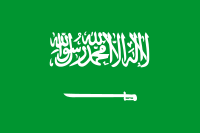 Saudi Arabia
Saudi Arabia- The Royal Saudi Air Force operates 72 F-15S.
 Singapore
Singapore- The Republic of Singapore Air Force has ordered 24 F-15SG.
 United States
United States- The USAF currently operates the F-15E, with 224 in service. (Bolded are active units)
- Active Duty[48]
- Air Combat Command
- 4th Fighter Wing - Seymour Johnson AFB, North Carolina
- 333d Fighter Squadron
- 334th Fighter Squadron
- 335th Fighter Squadron
- 336th Fighter Squadron
- 53d Wing - Eglin AFB, Florida
- 85th Test and Evaluation Squadron
- 422d Test and Evaluation Squadron - Nellis AFB, Nevada
- 57th Wing - Nellis AFB, Nevada
- 17th Weapons Squadron
- 366th Fighter Wing - Mountain Home AFB, Idaho
- 389th Fighter Squadron
- 391st Fighter Squadron
- 4th Fighter Wing - Seymour Johnson AFB, North Carolina
- United States Air Forces in Europe
- 48th Fighter Wing - RAF Lakenheath, England
- 492d Fighter Squadron
- 494th Fighter Squadron
- 48th Fighter Wing - RAF Lakenheath, England
- Air Education and Training Command
- 405th Tactical Training Wing / 58th Fighter Wing / 56th Fighter Wing - Luke AFB, Arizona
- 461st Fighter Squadron - inactivated
- 550th Fighter Squadron - inactivated
- 555th Fighter Squadron - moved to Aviano AB, Italy & reequipped with F-16C
- 405th Tactical Training Wing / 58th Fighter Wing / 56th Fighter Wing - Luke AFB, Arizona
- Pacific Air Forces
- 3d Wing - Elmendorf AFB, Alaska
- 90th Fighter Squadron - reequiped with F-22
- 3d Wing - Elmendorf AFB, Alaska
- Air Combat Command
Specifications (F-15E)
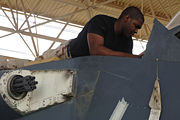
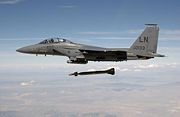
Data from USAF fact sheet,[1] Davies[49]
General characteristics
- Crew: 2
- Length: 63.8 ft (19.4 m)
- Wingspan: 42.8 ft (13.05 m)
- Height: 18.5 ft (5.63 m)
- Wing area: 608 ft² (56.5 m²)
- Airfoil: NACA 64A006.6 root, NACA 64A203 tip
- Empty weight: 31,700 lb (14,300 kg)
- Max takeoff weight: 81,000 lb (36,700 kg)
- Powerplant: 2× Pratt & Whitney F100-229 afterburning turbofans, 29,000 lbf (129 kN) each
Performance
- Maximum speed: Mach 2.5+ (1,650+ mph, 2,660+ km/h)
- Ferry range: 2,400 mi (2,100 nmi, 3,900 km) with conformal fuel tank and three external fuel tanks
- Service ceiling 60,000 ft (18,200 m)
- Rate of climb: 50,000+ ft/min (254+ m/s)
Armament
- Guns: 1× 20 mm (0.787 in) M61 Vulcan gatling gun, 510 rounds of either M-56 or PGU-28 ammunition
- Hardpoints: 2 wing pylons, fuselage pylons, bomb racks on CFTs with a capacity of 24,250 lb (11,000 kg) external fuel and ordnance,
- Missiles:
- Air-to-air missiles:
- 2× AIM-9M Sidewinder or 2× AIM-120 AMRAAM, and
- 4× AIM-7M Sparrow or additional 4× AIM-120 AMRAAM
- Air-to-surface missiles:
- 6× AGM-65 Maverick
- AGM-130
- AGM-84 Harpoon
- AGM-84K SLAM-ER
- AGM-154 JSOW
- AGM-158 JASSM
- Air-to-air missiles:
- Bombs:
- B61 nuclear bomb
- Mark 82 bomb
- Mark 84 bomb
- CBU-87 Combined Effects Munition
- CBU-89 Gator
- CBU-97 Sensor Fuzed Weapon
- CBU-103 CEM
- CBU-104 Gator
- CBU-105 SFW
- GBU-10 Paveway II
- GBU-12 Paveway II
- GBU-15
- GBU-24 Paveway III
- GBU-27 Paveway III
- GBU-28
- GBU-31 JDAM
- GBU-38 JDAM
- GBU-39 Small Diameter Bomb
- GBU-54 Laser JDAM
- Others:
- SUU-42A/A Flares/Infrared decoys dispenser pod and chaff pod or
- AN/ALQ-131 ECM pod or
- LANTIRN, Lockheed Martin Sniper XR & LITENING targeting pods or
- up to 3× 600 US gallon Sargent Fletcher drop tanks for ferry flight or extended range/loitering time.
See also
- 4th generation jet fighter
Related development
Comparable aircraft
- Sukhoi Su-30
- Dassault Rafale
- Eurofighter Typhoon
- Sukhoi Su-34
- Panavia Tornado
Related lists
- List of fighter aircraft
- List of military aircraft of the United States
References
- ↑ 1.0 1.1 F-15E Strike Eagle fact sheet, USAF, October 2007.
- ↑ F-15E Eagle, Aerospaceweb.org.
- ↑ 3.0 3.1 3.2 James R. Ciborski. The F-15 Eagle: A Chronology. History Office, Aeronautical Systems Center, Air Force Materiel Command, Wright-Patterson AFB, Ohio. June 2002.
- ↑ "Raytheon claims AESA upgrade contract for F-15E", Flightglobal.com, 1 November 2007.
- ↑ "Boeing Selects Raytheon to Provide AESA Radar for U.S. Air Force F-15E Strike Eagles", Boeing, 1 November 2007.
- ↑ Making the Best of the Fighter Force, Air Force magazine, March 2007.
- ↑ Dr Richard P. Hallion. A Troubling Past:Air Force Fighter Acquisition since 1945. Airpower Journal. Winter 1990.
- ↑ Jenkins 1998, p. 35-36.
- ↑ Davies 2003, pp. 63-36.
- ↑ 10.0 10.1 "Tim Bennett's War", Air Force magazine online, January 1993.
- ↑ Davies 2005, Chapter Two - Desert Shield and Desert Storm, pp. 17-24.
- ↑ Davies 2005, Chapter Two - Desert Shield and Desert Storm, pp. 29-30.
- ↑ Davies 2005, Chapter Two - Desert Shield and Desert Storm, pp. 30-31.
- ↑ Davies 2005, Chapter Three - No-Fly Zones, p. 33.
- ↑ Davies 2005, Chapter Three - No-Fly Zones, p. 35-36.
- ↑ Davies 2005, Chapter Four - Deny Flight and Allied Force, pp. 43.
- ↑ 17.0 17.1 Davies 2005, Chapter Four - Deny Flight and Allied Force, p. 44.
- ↑ Davies 2005, Chapter Four - Deny Flight and Allied Force, p. 46.
- ↑ 19.0 19.1 Davies 2005, Chapter Four - Deny Flight and Allied Force, p. 47.
- ↑ Davies 2005, Chapter Four - Deny Flight and Allied Force, p. 59.
- ↑ Davies 2005. Chapter Five - Afghan Rebels, p. 63.
- ↑ 22.0 22.1 Davies 2005, Chapter Five - Afghan Rebels, p. 64.
- ↑ Davies 2005, Chapter Five - Afghan Rebels, p. 65.
- ↑ Davies 2005, Chapter Five - Afghan Rebels, p. 68-69.
- ↑ 25.0 25.1 Davies 2005, Chapter Five - Afghan Rebels, p. 72.
- ↑ 26.0 26.1 Davies 2005, Chapter Five - Afghan Rebels, p. 73.
- ↑ Davies 2005, Chapter Five - Afghan Rebels, p. 76.
- ↑ "Outcry as 'friendly fire' kills three UK soldiers". The Telegraph. 25 August 2007.
- ↑ 29.0 29.1 Davies 2005, Chapter Six - Operation Iraqi Freedom, p. 77-78.
- ↑ 30.0 30.1 Davies 2005, Chapter Six - Operation Iraqi Freedom, p. 80.
- ↑ 31.0 31.1 Davies 2005, Chapter Six - Operation Iraqi Freedom, p. 82.
- ↑ Davies 2005, Chapter Six - Operation Iraqi Freedom, p. 83.
- ↑ Dao, James. A Trail of Pain From a Botched Attack in Iraq in 2003. The New York Times, 15 April 2005.
- ↑ Das and Watkins, Unofficial Arlington National Cemetery page.
- ↑ Das Given Posthumous Awards Former Amarilloan honored in death. Air Force Times via Ammarillo Globe-News, 18 August 2003.
- ↑ naver.com news article
- ↑ F-15K’s First Flight Successful, Defense Industry Daily, 7 March 2005.
- ↑ Yonhap News, served by Naver
- ↑ Boeing F-15K Eagle, Flug Revue, 5 May 2008.
- ↑ General Electric Aerospace article
- ↑ "Singapore finally opts for F-15T", Flight International, 13 September 2005.
- ↑ DSCA notification to the US Congress about the Singapore F-15 FMS
- ↑ Singapore Exercises Option for Additional F-15SGs, Singapore Ministry of Defence, October 22, 2007.
- ↑ "Boeing Rolls Out 1st F-15SG to Singapore", Boeing, 3 November 2008.
- ↑ F-16.net - Thirty new F-16 block 52+ aircraft for Greece
- ↑ AeroWorldNet(tm) - Greece Buys 50 F-16s and 15 Mirage 2000s [May 3, 1999]
- ↑ Duk-kun, Byun. "Air Force receives last shipment of F-15K fighter jet", Yonhap News, 8 October 2008.
- ↑ Air Force Historical Research Agency
- ↑ Davies 2002, Appendix 1
- Davies, Steve. Combat Legend, F-15 Eagle and Strike Eagle. London: Airlife Publishing, Ltd., 2002. ISBN 1-84037-377-6.
- Davies, Steve. Boeing F-15E Strike Eagle, All-Weather Attack Aircraft, Airlife Publishing, Ltd., 2003. ISBN 1-84037-378-4.
- Davies, Steve. F-15E Strike Eagle Units In Combat 1990-2005, Osprey Publishing Limited., 2005. ISBN 1841769096.
- Jenkins, Dennis R. McDonnell Douglas F-15 Eagle, Supreme Heavy-Weight Fighter. Arlington, TX: Aerofax, 1998. ISBN 1-85780-081-8.
- Smallwood, William L. "Strike Eagle - Flying the F-15E In The Gulf War", Brassey's, 1994.
- Boeing F-15K website
External links
- F-15E USAF fact sheet
- F-15E page on Boeing.com
- F-15E Strike Eagle.com
- F-15E web site
- F-15E on USAF National Museum web site
|
||||||||||||||||||||||||||
|
||||||||||||||
